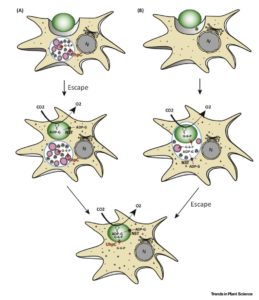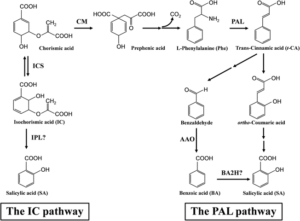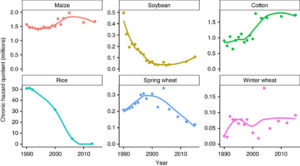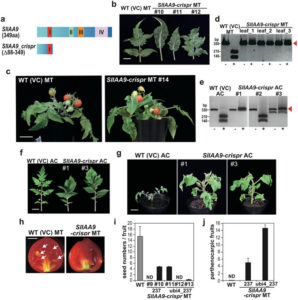Opinion: Ménage-à-trois hypothesis of plastid endosymbiosis ($)
 It is well established that plastids are derived from the primary endosymbiosis of an ancient cyanobacterium into a eukaryotic host cell, but this understanding does not explain all of the evidence, nor does it explain how the nascent endosymbiont evaded the host cell’s defense mechanisms. Recently, the ménage-à-trois hypothesis (MATH) was proposed. According to MATH, the eukaryotic host of the photosynthetic cyanobacterium also hosted an intracellular chlamydial pathogen (Chlamydiales are obligate intracellular bacterial pathogens and include the causal agent of a human sexually-transmitted disease). Cenci et al. review the evidence for MATH, which includes the presence of Chlamydiales genes in the eukaryotic host’s nucleus, and evidence of transporters and metabolic pathways of Chlymydiales origin. This hypothesis suggests that the success of the primary endosymbiosis was due in part to a pre-adaptation of the host that facilitated its success. Trends Plant Sci. 10.1016/j.tplants.2016.12.007
It is well established that plastids are derived from the primary endosymbiosis of an ancient cyanobacterium into a eukaryotic host cell, but this understanding does not explain all of the evidence, nor does it explain how the nascent endosymbiont evaded the host cell’s defense mechanisms. Recently, the ménage-à-trois hypothesis (MATH) was proposed. According to MATH, the eukaryotic host of the photosynthetic cyanobacterium also hosted an intracellular chlamydial pathogen (Chlamydiales are obligate intracellular bacterial pathogens and include the causal agent of a human sexually-transmitted disease). Cenci et al. review the evidence for MATH, which includes the presence of Chlamydiales genes in the eukaryotic host’s nucleus, and evidence of transporters and metabolic pathways of Chlymydiales origin. This hypothesis suggests that the success of the primary endosymbiosis was due in part to a pre-adaptation of the host that facilitated its success. Trends Plant Sci. 10.1016/j.tplants.2016.12.007


 Pollination is an important evolutionary process as it allows gene flow. If pollen travels long distances, the likelihood of inbreeding is reduced and fitness may be increased. Pollen dispersal can be assisted by pollinators, and although most plants are pollinated by insects, birds are also important and contribute to pollination of around 500 vascular plant genera. In this review, Krauss et al. stress the importance of birds to pollen movement and how plant mating is affected by bird behavior. Bird pollination is a strong predictor of multiple paternity, which impacts genetic diversity and, in consequence, competition for maternal resources during seed maturation. Bird populations are also affected by climate change; a decline or range shift may also affect plant populations, especially in areas where plants rely on birds as pollinators, such as the tropics and the Southern Hemisphere. Keeping in mind the importance of birds for plant mating may help with restoration efforts under future climate change scenarios. (Summary by
Pollination is an important evolutionary process as it allows gene flow. If pollen travels long distances, the likelihood of inbreeding is reduced and fitness may be increased. Pollen dispersal can be assisted by pollinators, and although most plants are pollinated by insects, birds are also important and contribute to pollination of around 500 vascular plant genera. In this review, Krauss et al. stress the importance of birds to pollen movement and how plant mating is affected by bird behavior. Bird pollination is a strong predictor of multiple paternity, which impacts genetic diversity and, in consequence, competition for maternal resources during seed maturation. Bird populations are also affected by climate change; a decline or range shift may also affect plant populations, especially in areas where plants rely on birds as pollinators, such as the tropics and the Southern Hemisphere. Keeping in mind the importance of birds for plant mating may help with restoration efforts under future climate change scenarios. (Summary by  Photosynthetic capacity varies hugely within an individual over time, between individuals in different environments, and between species. Demming-Adams et al. review the processes that affect intrinsic photosynthetic capacity. Plants modulate their intrinsic photosynthetic capacity according to input (e.g., shade-grown plants generally have a lower capacity than plants growing in bright light), and demand (e.g., rate of export of photosynthetic products from the leaf and sink strength). Photosynthetic capacity can be governed by light harvesting capacity or CO2-fixing capacity and is affected by transport capacity, leaf thickness, developmental stage, temperature, stress and other factors. Understanding these factors can lead to increases in crop productivity. Curr. Opin. Plant Biol.
Photosynthetic capacity varies hugely within an individual over time, between individuals in different environments, and between species. Demming-Adams et al. review the processes that affect intrinsic photosynthetic capacity. Plants modulate their intrinsic photosynthetic capacity according to input (e.g., shade-grown plants generally have a lower capacity than plants growing in bright light), and demand (e.g., rate of export of photosynthetic products from the leaf and sink strength). Photosynthetic capacity can be governed by light harvesting capacity or CO2-fixing capacity and is affected by transport capacity, leaf thickness, developmental stage, temperature, stress and other factors. Understanding these factors can lead to increases in crop productivity. Curr. Opin. Plant Biol.  The journal BMC Biology publishes occasional Question and Answer articles, including a
The journal BMC Biology publishes occasional Question and Answer articles, including a  A series of letters has been published in Nature Biotechnology on the topic of the US National Academies report
A series of letters has been published in Nature Biotechnology on the topic of the US National Academies report  There are many subspecies of Brassica rapa [including turnip (subsp. rapa) pak choi (subsp. chinensis) and Chinese cabbage (subsp. pekinensis)] but the relationships between the subspecies has remained uncertain. Qi et al. sequenced 143 accessions, including some subspecies for the first time. They then used genomics approaches to develop a phylogeny. They corroborate their molecular findings with written records (the domestication of B. rapa has occurred within the timespan of written history), making this an intriguing article for students interested in the history of agriculture as well as population genomics. Molec. Ecol.
There are many subspecies of Brassica rapa [including turnip (subsp. rapa) pak choi (subsp. chinensis) and Chinese cabbage (subsp. pekinensis)] but the relationships between the subspecies has remained uncertain. Qi et al. sequenced 143 accessions, including some subspecies for the first time. They then used genomics approaches to develop a phylogeny. They corroborate their molecular findings with written records (the domestication of B. rapa has occurred within the timespan of written history), making this an intriguing article for students interested in the history of agriculture as well as population genomics. Molec. Ecol.  “Weeds are a fact of life for farmers around the world,” writes Kniss in this analysis of herbicide-use trends. He stresses the limitation of reports that measure only the weight of herbicides used, as there is tremendous variation in the toxicity of different herbicides. He shows that although herbicide use intensity has risen, for many crops both chronic (accumulating) and acute (leading to death) herbicide toxicity has decreased. He discusses the contribution of the widely-used but lower-toxicity glyphosate to this trend, as well as the impact of glyphosate-resistant GM crops on herbicide use. Nature Comms.
“Weeds are a fact of life for farmers around the world,” writes Kniss in this analysis of herbicide-use trends. He stresses the limitation of reports that measure only the weight of herbicides used, as there is tremendous variation in the toxicity of different herbicides. He shows that although herbicide use intensity has risen, for many crops both chronic (accumulating) and acute (leading to death) herbicide toxicity has decreased. He discusses the contribution of the widely-used but lower-toxicity glyphosate to this trend, as well as the impact of glyphosate-resistant GM crops on herbicide use. Nature Comms.  Most fruits form after pollination, making their production vulnerable to pollinator presence. Parthenocarpy is the development of fruit that occurs in the absence of pollination. Genes that enable parthenocarpy have been identified, including a tomato gene involved in auxin responses SlIAA9. Ueta et al. used CRISPR/Cas9 to efficiently engineer parthenocarpy into two commercial tomato varieties. One outcome of this research could be sustained fruit yields even when pollinator populations decline. Sci. Reports.
Most fruits form after pollination, making their production vulnerable to pollinator presence. Parthenocarpy is the development of fruit that occurs in the absence of pollination. Genes that enable parthenocarpy have been identified, including a tomato gene involved in auxin responses SlIAA9. Ueta et al. used CRISPR/Cas9 to efficiently engineer parthenocarpy into two commercial tomato varieties. One outcome of this research could be sustained fruit yields even when pollinator populations decline. Sci. Reports.